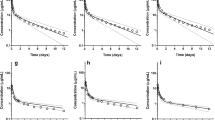Abstract
A stochastic control strategy for individualizing teicoplanin dosing schedule in neutropenic patients is proposed and compared to the usual Bayesian approach based on the mode of the posterior density of the model parameters. Teicoplanin disposition is described by a bicompurlmental model. Age, body weight, serum creatinine, white blood cell count, and sex can be included as covariates. Posterior density of model parameters is obtained by Bayes theorem under a discrete form from which the posterior density of leicoplanin trough concentrations are computed for any dosing schedule. Optimal maintenance dose is determined by minimizing the cost associated, through a logarithmic risk function, to the concentrations being outside the therapeutic range. In Monte Carlo simulation studies on 300 individuals, stochastic control was more accurate than, and equally precise as the usual Bayesian approach. Two-sample based predictions were not better than one-sample based ones. Inclusion of covariates in the model improved dramatically the performances of both strategies. A small retrospective study based on real data (n = 16 patients) shows that reasonable accuracy (bias of 0.7 mg/L) and precision (3 mg/L) in teicoplanin trough concentration prediction is obtained with both strategies provided that covariates are taken into account.
Similar content being viewed by others
REFERENCES
A. P. R. Wilson, R. N. Grüneberg, and H. Neu. A critical review of the dosage of teicoplanin in Europe and the USA. Int. J. Antimicrob. Agents 4(Suppl. 1):S1–S30 (1994).
F. Menichetti, P. Martino, G. Bucaneve, et al. Effects of teicoplanin and those of vancomycin in initial empirical antibiotic regimen for febrile neutropenic patients with hematologic malignancies. Antimicrob. Agents Chemother. 38:2041–2046 (1994).
O. Lortholary, M. Tod, N. Rizzo, C. Padoin, O. Biard, P. Casassus, L. Guillevin, and O. Petitjean. Population pharmacokinetic study of teicoplanin in severely neutropenic patients. Antimicrob. Agents Chemother. 40:1242–1247 (1996).
D. Greenwood, K. Bigdood, and M. Turner. A comparison of the responses of staphylococci and streptococci to teicoplanin and vancomycin. J. Antimicrob. Agents 20:155–164 (1987).
B. Vogelman, S. Gudmunsson, J. Legett, J. Tumidge, S. Ebert, and W. A. Craig. Correlation of antimicrobial pharmacokinetic parameters with therapeutic efficacy in an animal model. J. Infect. Dis. 158:831–847 (1988).
H. F. Chambers and S. Kennedy. Effects of dosage, peak and trough concentrations in serum, protein binding and bactericidal rate on efficacy of teicoplanin in a rabbit model of endocarditis. Antimicrob. Agents Chemother. 34:510–514 (1990).
A. E. Zimmerman, B. G. Katona, and K. I. Plaisance. Association of vancomycin serum concentrations with outcomes in patients with Gram-positive bacteremia. Pharmacotherapy 15:85–91 (1995).
P. L. Carver, C. H. Nightingale, R. Quintiliani, K. Sweeney, R. C. Stevens, and E. Madezo. Pharmacokinetics of single-and multiple-dose teicoplanin in healthy volunteers. Antimicrob. Agents Chemother. 33:82–86 (1989).
J. A. Smithers, H. K. Kulmala, G. A. Thompson, K. K. Anthony, E. W. Lewis, S. J. Ruberg, M. T. Kenny, J. K. Dulworth, and M. A. Brackman. Pharmacokinetics of teicoplanin upon multiple-dose intravenous administration to healthy volunteers. Antimicrob. Agents Chemother. 36:115–120 (1992).
K. Katz and D. Z. D'Argenio. Implementation and evaluation of control strategies for individualizing dosage regimens, with application to the aminoglycosides antibiotics. J. Pharmacokin. Biopharm. 14:523–537 (1986).
N. Taright, F. Mentré, A. Mallet, and R. Jouvent. Nonparametric estimation of population characteristics of the kinetics of lithium from observational and experimental data: Individualization of chronic dosing regimen using a new Bayesian approach. Ther. Drug Monit. 16:258–269 (1994).
J. C. Wakefield. An expected loss approach to the design of dosage regimens via sampling based methods. Statistician 43:13–29 (1994).
J. C. Wakefield. Bayesian individualisation via sampling-based methods. J. Pharmacokin. Biopharm. 24:103–131 (1996).
J. G. Wagner. Pharmacokinetics for the Pharmaceutical Scientist, Technomic, Lancaster, PA, 1993.
D. W. Cockroft and M. H. Gault. Prediction of creatinine clearance from serum creatinine. Nephron 16:31–41 (1976).
F. Mentre, A. Mallet and D. Baccart. Optimal design in random effects models. Biometrika 84:429–442 (1997).
W. H. Press, S. A. Teukolsky, W. T. Vetterling, and B. P. Flannery. Numerical Recipes in C: The Art of Scientific Computing, Cambridge University Press, Cambridge, U.K., 1992.
L. B. Sheiner and S. Beal. Some suggestions for measuring predictive performances. J. Pharmacokin. Biopharm. 9:503–513 (1981).
Y. Tanigawara, I. Yano, K. Kawakatsu, K. Nishimura, M. Yasuhara, and R. Hori. Predictive performance of the Bayesian analysis: Effect of blood sampling time, population parameters and pharmacostatistical model. J. Pharmacokin. Biopharm. 22:59–71 (1994).
S. Vozeh and C. Steiner. Estimates of the population pharmacokinetic parameters and performance of Bayesian feed back: A sensitivity analysis. J. Pharmacokin. Biopharm. 15:511–528 (1987).
Author information
Authors and Affiliations
Rights and permissions
About this article
Cite this article
Tod, M., Alet, P., Lortholary, O. et al. Implementation and Evaluation of a Stochastic Control Strategy for Individualizing Teicoplanin Dosage Regimen. J Pharmacokinet Pharmacodyn 25, 695–712 (1997). https://doi.org/10.1023/A:1025729817252
Published:
Issue Date:
DOI: https://doi.org/10.1023/A:1025729817252




